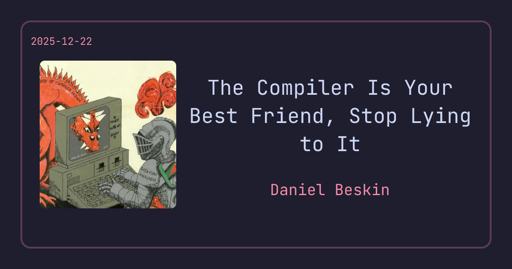- 6 Posts
- 457 Comments
Curl.

 2·7 days ago
2·7 days agoCheck your spam folder. I don’t know that I’ve ever not received an email I was supposed to have received and found that the spam folder was actually the issue. But it’s still a good idea to check it in case that’s the whole issue.

 1·8 days ago
1·8 days agoHey thank you! I’m glad to hear some interest in it. I’ve definitely got ideas as far as how I’d like to see it improve moving forward (some syntactic sugar, more sophisticated ways of drawing “people”/creatures/skeletons/etc, maybe vector graphics output support – no project is ever really done, you know.) I’m on another project at the moment, but if it got enough interest, I’d probably be inclined to put more work into it.
I don’t have a TTRPG campaign running right now (which is what I wrote it for), so I’m not “eating my own dog food” very much with that particular project. But I would love to do more with it. Only reason I’m not already is because I’ve got so many other projects I want to work on. Heh.
The main project I’m working on lately has been that 3D game assets DSL that I mentioned later in my post. It’s probably quite a bit more ambitious than codecomic (it’s actually Turing complete which definitely adds to the challenge), but I do see a point approaching where it’s feature-complete enough to at least publish an alpha version. It also definitely needs a lot more code comments/documentation before I publish. Probably still months away, but it feels a lot closer than it did last week. Heh.
Anyway, thanks again for the complement!

 3·11 days ago
3·11 days ago“You?” As in me? I’m confused.

 22·11 days ago
22·11 days agoAh. Ok. I did watch it at double speed, so I guess I can’t really argue.

 217·11 days ago
217·11 days agoWhat was wrong with the video exactly?

 1410·11 days ago
1410·11 days agoI heartily approve.

 6·11 days ago
6·11 days agoThat’s… kindof the question, isn’t it?
(Disclaimer: I haven’t seen the video yet. But yeah.)
That’s a quantum mechanics thing. And quantum mechanics has a long history of making physicists and physics students really uncomfortable. The following two quotes illustrate just how fucked up quantum mechanics really is:
God does not play dice
- Albert Einstein
I don’t like it, and I’m sorry I ever had anything to do with it.
- Erwin Schrödinger
Before quantum mechanics, our Newtonian understanding of the world was really simple. We thought particles were little billiard balls floating around and bumping into each other and being attracted and repelled by electric fields and such. But nope! Turns out you can’t even conceptually understand what’s going on at that scale without making the observer/measurer/measurement a central feature of the literal math. But if you don’t do the uncomfortable things in the math, you can’t get results from the math that match what happens in the real world.
W.
T.
F.
Seriously. You’re asking exactly the right question. The question that made the discoverers of quantum mechanics uncomfortable in the first place. Unfortunately, there’s no one answer to it. There are a bunch.
In practice, you don’t really have to have “the answer” to that question to design functioning solid-state storage devices or predict the half-life of a muon. You can just kindof throw up your hands and take it for wrote that “the spin doesn’t exist until it’s measured” (nor the position nor the velocity nor any of a bunch of other such properties of the particles in the system). But it’s not like physicist don’t still have this question in the back of their minds keeping them up at night.

 330·13 days ago
330·13 days agoBecause fuck you, that’s why.
- Microsoft
Saved you a click.

 6·15 days ago
6·15 days agoHere’s my GitLab. None of it’s “active” really. I’m the only contributor to most things I have on GitLab. At least some of the things there, if they started getting attention and interest, I might very likely make them active. But for now, they’re just out there and may or may not receive further updates. Though I’m working on other projects I specifically intend to publish as FOSS in the future.
- Simple-CSS-Shrinker was made for a web-based game I wrote back in the day. I ought to dust that game off and publish it.
- JeSter, the JS tester. A really simple JS unit testing framework that runs in a browser and doesn’t require Node or V8 or anything. Made in service to the same game I mentioned in the previous item.
- pystocking was basically in service of hydrogen_proxy
- hydrogen_proxy is a “scriptable HTTP proxy” written in Python. Definitely intended for privacy kind of applications. But it’s kinda slow. I have in the back of my mind to rewrite it in Go, but it’s not high on my priority list. (I’m honestly mulling the idea of quitting the use of browsers all together if I can wrangle a way to do that that doesn’t involve switching to a bunch of proprietary software. The main browsers are bullshit these days.)
- GoVTT was written because I wanted to play a TTRPG with friends remotely. It’s a web-based virtual tabletop application that you can self-host. I may some day offer hosting for it. (Like, if you want to use it but don’t want to be bothered to go through the hassle of hosting it yourself, maybe I’ll offer to host it for a small fee.) No guarantees, though, except that it’ll always be FOSS and it’ll always be an option to self-host.
- codecomic is a domain-specific language for making simple webcomics or story boards. I made it because I wanted to be able to include webcomics/story boards in my game mastering notes, which are managed with a system that I should also publish as FOSS.
My main side-projects right now that I haven’t published yet are:
- A domain-specific language for building 3d game assets. Roughly speaking, FreeCAD is to OpenSCAD as Blender is to what I’m currently working on building. (It’s in the early stages right now. I intend for it to be able to do modeling, rigging, animations, textures, normals, etc. All in the DSL’s syntax. I’m making progress, but of course that project is ridiculously ambitious. We’ll see where it is in a year.)
- A framework for rapidly prototyping 3d-printable mechanical keyboards. (Also pretty ridiculously ambitious.) The image below is a sneak peak at the first keyboard I’m intending to build with it. Some day.


 4·26 days ago
4·26 days agoOut of curiosity, I went and found the OrcaSlicer ticket where they’re working on adding the bricklaying feature to OrcaSlicer. Seems like they’re just hoping it doesn’t attract Stratasys’ attention.
Even if they have to remove the feature, it’ll still be in the history of the repo and it should be relatively easy to unrevert and rebuild personally on one’s own computer if necessary. Until the codebase changes enough to make it harder to maintain the fork.

 18·28 days ago
18·28 days agoStratasys still has a patent on it
That’s putting it generously, isn’t it?
This video from a year ago goes into why the patent they have today isn’t valid. (Short answer: prior art. They patented it in 1995 and that expired in 2015 in the U.S. and 2016 in Europe. Then they re-patented it in 2020, which isn’t really something they can do, but the patent office granted it anyway, probably unaware of the prior patent. There’s kindof a “new claim” in the later patent, but there’s prior art for that as well in the form of a 2019 feature request on PrusaSlicer’s Github.)
I get that Stratasys has lawyers and money and might theoretically be able to win even a case with as little merit as a patent case regarding that 2020 patent would have. But I’m not sure I’d go so far as to say they have a (valid) patent.

 20·1 month ago
20·1 month agoPut them in Soma.
If you know, you know.

 15·1 month ago
15·1 month agoAt least in my peer group, people hated Voyager when it was running too.
That’s why you give them a laptop and a Gentoo install iso on a bootable pen drive before they can talk.
“Billy, did you use genkernel rather than manually configuring and building your kernel?”
“Yes, Dad…”
“You know what that means.”
“Yes, Dad. No allowance for two weeks.”

 7·1 month ago
7·1 month agoJava, Postgres mostly but also LDAP and random in-house-written RESTful services, almost 20 years.
- The objects we store in the Postgres database are very “hierarchical” in nature, with one top-level object and lots of child/grandchild/great-grandchild objects. (We asked for a Mongo database but the infra team at the time said "make do with Postgres.)
- As I mentioned, some of that hierarchy is in LDAP or RESTful services, not in Postgres, so we needed something capable of dealing with multiple storage backends that would stitch the objects together as necessary. So the “ORM” needed to have backends for multiple backend systems.
- We knew clients would need a vast number of different queries. So we made a RESTful endpoint that gave the full power of the ORM to (authorized) clients. If they needed different data, we’d be like “change your query like this” and they didn’t have to wait on us.
- Early in the project, we consciously designed an extensible JSON representation of our hierarchical objects. That is what’s returned from the aforementioned RESTful endpoint.
- However, we also created a “shortcuts” system to allow us to “balance” how much of the logic lived on the server vs in the client. (It can mix and match. Like “apply this shortcut, but also filter this way and paginate” or whatever.)
- We made the API of the ORM such that it could both be used to query from the database/LDAP/RESTful systems, or be used as a client SDK for the aforementioned RESTful query endpoint that the application exposed.
- It’s both “more than an ORM” (querying from non-database sort of backends) and not fully an ORM (read only, doesn’t handle schema evolution.) But it’s fair to say it’s more “an ORM” than “not an ORM”.
- The implementation of the Postgres backend part of it is heavily inspired by Django’s ORM.
We couldn’t have pressed Hibernate into this use case. It doesn’t really deal with hierarchical data and sure as hell doesn’t know how to query from LDAP. I don’t know that anything existed at the time (nor am I sure anything exists now) that would fulfill our use case.
And the alternative to what we built was a massive, unmaintainable DAO with ridiculous numbers of individual queries in it that would have to be modified or added to endlessly every time someone needed to filter a bit differently or whatever.

 22·1 month ago
22·1 month agoThis was a developed-in-house e-commerce web application at a major e-retailer. So fortunately that monstrosity of a cookie-handling mess was only ever used by one company.
You know what, though? Talking about this reminds me of another story about the same e-commerce application.
After a customer placed an order on this e-commerce site, the company’s fraud department had to evaluate the order to make sure it wasn’t fraudulently placed. (As in, with a credit card not owned or authorized for use by the purchaser.) Once that was done, the order had to be communicated to a worker at the warehouse so they could pack the right items into a box, put on a shipping label, and set the box aside to be picked up by the UPS truck which would come once a day near the end of the day.
The application used by the fraud department and the application that displayed new orders to warehouse workers was one and the same application. Whether a user had fraud-evaluating powers or pack-items-in-boxes powers just depended on what permissions their particular user had. (That may have been decided by LDAP groups. I don’t remember for sure.)
Meanwhile, the e-commerce site offered gift cards for sale online. The gift card would be shipped to the customer. And there was a box where you could write a message associated with the gift card. So, for instance, someone could buy a gift card to be sent to their nephew’s address or whatever and include a little note like “Happy Birthday. Don’t spend it all at once.” or whatever. And the fraud/pick-and-pack application would display all details of the order including any messages associated with the gift cards.
Well, I found a stored cross-site scripting vulnerability where if you put
<script>...</script>tags with some JavaScript in the gift card message box and completed the order, the JavaScript would execute any time someone viewed the details page for the order in the fraud/pick-and-pack application. And of course, the JavaScript could do within that application just about anything the user could do with their given permissions.The main danger was that a malicious actor with sufficient knowledge of how our fraud application worked could place an order fraudulently with someone else’s credit card and include in the order a gift card with a malicious JavaScript payload in the message box, and then that malicious JavaScript could automatically mark the order “a-ok, no fraud here” when a fraud department worker loaded the order details page, letting the order be fulfilled without any actual fraud review.
The fix was pretty simple. Just stick a
<c:out>...</c:out>in the appropriate place in the fraud/pick-and-pack application code. But it was an interesting example of a vulnerability in a not-customer-facing application that could none-the-less be exploited by any public customer/user without any particular special access.If you’re interested in one more interesting story about the same e-commerce application, see this comment I made a while ago.

 212·1 month ago
212·1 month agoNever roll your own ORM
I’ve done this. Probably 10 years ago. Even today, I maintain the same application that has the ORM in it that I designed. If I could go back in time and do something else, I’d do the same thing again. Honest to god. For my use case, I feel it was warranted. It was risky, but it worked out surprisingly well.

 43·1 month ago
43·1 month agoJava webapp. Customer facing. E-commerce application, so in PCI scope and dealt with credit card info and such.
There was one specific cookie that stored some site-wide preference for the customer. (Why not just put that preference in the database associated with the user? Because that would make too much sense is why.)
But the way they encoded the data to go into the cookie? Take the data, use the Java serialization framework (which is like Python’s “Pickle” or Go’s “Gob”) to turn that into a string. But that string has binary data in it and raw binary data is kindof weird to put in a cookie, so you base64 encode the result. (The base64 encoding was the only sane step in the whole process.) Then you do the reverse when you receive the cookie back from the browser. (And no, there was no signature check or anything.)
The thing about the Java serialization framework, though is that decoding back into Java objects runs arbitrary object constructors and such. As in, arbitrary code execution. And there’s no checking in the deserialization part of the Java serialization framework until your code tries to cast the object to whatever type you’re expecting. And by that point, the arbitrary code execution has already happened. In short, this left a gaping vulnerability that could easily have been used to extremely ill effect, like a payment information breach or some such.
So all a malicious user had to do to run arbitrary code on our application server was serialize something, base64 encode it, and then send it to our servers as a cookie value. (Insert nail biting here.)
When we found out that there was a severe vulnerability, I got the task of closing the hole. But the existing cookies had to continue to be honored. The boss wasn’t ok with just not honoring the old cookies and developing a new cookie format that didn’t involve the Java serialization framework.
So I went and learned enough about the internal workings of how the Java serialization framework turned a Java value into a binary blob to write custom code that worked for only the subset of the Java serialization format that we absolutely needed for this use case and no more. And my custom code did not allow for arbitrary code execution. It was weird and gross and I made sure to leave a great big comment talking about why we’d do such a thing. But it closed the vulnerability while still honoring all the existing cookies, making it so that customers didn’t lose the preference they’d set. I was proud of it, even though it was weird and gross.
The value that was serialized to put into the cookie? A single Java int. Not a big POJO of any sort. Just a single solitary integer. They could just as well have “serialized” it using base-10 rather than using the Java serialization framework plus base64.



Bookmarked that shit so fuckin’ hard.